In Retrospect - Collection Focus: The Colour of Country
Written by co-curator Dr Melinda Mann
Download PDF here:
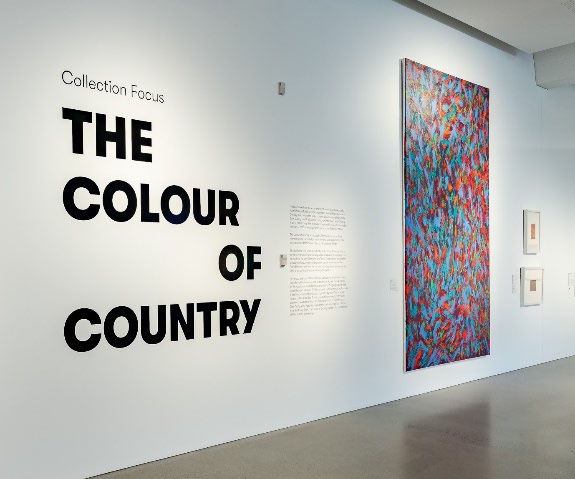
Image: Installation view, ‘Collection Focus: The Colour of Country’, Rockhampton Museum of Art, 2022. Photo: Nathan White Images. Image features Patrick Butcher (b. 1977) (Umpila) The Beauty Nature 2007, acrylic on Belgian linen. Gift of Patrick Corrigan AM through the Australian Government’s Cultural Gifts Program 2013.
At Rockhampton Museum of Art (RMOA), the large wall vinyl used for the exhibition title made an unmissable statement to every visitor who entered the space from October 2022 to February 2023. The Colour of Country lettering was big, black and bold. It served as a reminder of the relationship with these lands and of the people who have been part of it since time immemorial.
The exhibition, ‘Collection Focus: The Colour of Country’ was adjacent to ‘Legacy: Reflections on Mabo,’ which featured works from Indigenous and non-Indigenous artists that were commissioned to commemorate Uncle Eddie Koiki Mabo and the remarkable legal challenge: the Mabo Decision. The flow between the story of each exhibition, the works and the physical gallery spaces was intentional. Visitors glimpsed the worlds of Aboriginal and Torres Strait Islander people with the potential of appreciating why Indigenous people have constantly defended their world through many uprisings, resistances, challenges and campaigns since 1788. ‘The Colour of Country’ prepared visitors to understand the tensions created when Indigenous and non-Indigenous worldviews collide as addressed in the ‘Legacy: Reflections on Mabo’ exhibition.
This short essay is a reflection by co-curator Melinda Mann on behalf of co-curator Mario Mabo, of the curators’ purpose and process for the exhibition. Brief interpretations of the context of the works exhibited are offered.
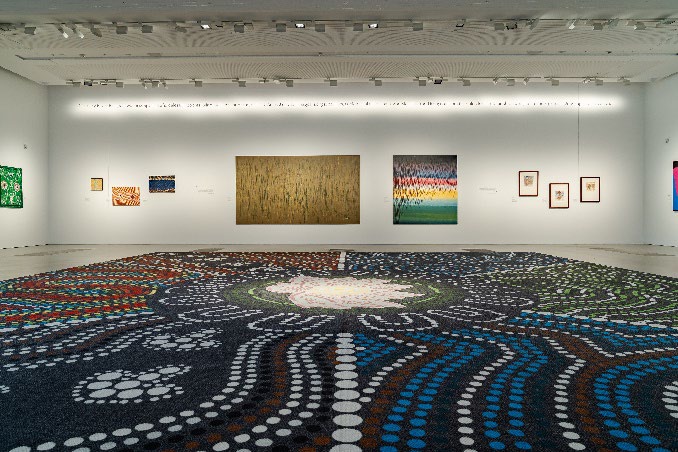
Image: Installation view, ‘The Colour of Country’, Rockhampton Museum of Art, 2022. Photo: Nathan White Images.
Relationships
From the very beginning stages of curation, ‘The Colour of Country’ set out to be authentic to Darumbal relationality. This concept is explained here at the beginning of this essay because it was critical to planning the exhibition and remains so in reflecting on it. Relationality is a term used to describe theories or theoretical frameworks that explain the nature of the relationships between individual elements and groups of elements. In the case of Indigenous relationality, it explains how Indigenous people live in relationship with physical, spiritual, environmental elements that are simultaneously past, present and future. Understanding the nature of these relationships as constant, reciprocal, consensual and sustainable is key to understanding Indigenous worldviews (McCoy, Elliot-Groves, Sabzalian, Bang, 2020). It holds that everything exists in relationship and not in isolation. To be Indigenous is to always remember where you are from, who you come from, how to live relationally (within the rules of relationships and not outside of them), and importantly how to adjust to disruptions without compromising Indigeneity. Darumbal relationality explains how relationships need to exist on Darumbal Country based on Darumbal people’s custodianship of lores for this specific place since time immemorial.
For this Collection Focus exhibition, one of many exhibitions curated from the Rockhampton Museum of Art Collection, RMOA leaned on its partnership with Darumbal people to adhere to relationship lores. The first step was to seek advice from the Darumbal People Aboriginal Corporation (DPAC is the Recognised Native Title Body) with the exhibition idea. It was put to DPAC that the exhibition would emphasise how Aboriginal and Torres Strait Islander people ‘know’ Country on a deep and ancient level and that it would also serve to tell an origin story for the Mabo case. DPAC advised RMOA that the exhibition needed input from the appropriate Torres Strait Islander community leaders and families. The local representatives, Melinda Mann (Darumbal) and Mario Mabo (Meriam) both living in Rockhampton, were approved by RMOA and DPAC as co-curators. Melinda is the First Nations Arts Officer at RMOA and Mario, the grandson of Uncle Eddie Koiki Mabo, is a recognised and respected member of the Mabo family in Rockhampton. This co-curator collaboration ensured decisions were made within the relationship between Darumbal Traditional Owners and the Mabo family representing the local Torres Strait Islander community, and not simply a matter of RMOA consulting the community as ‘stakeholders.’ The result was a curatorial process that centred cultural care and trust which nurtured — not strained — relationships.
Collection and Contestation
Works from the RMOA Collection drew primarily from local Aboriginal and Torres Strait Islander artists and secondarily from artists living in communities across Cape York, the Gulf of Carpentaria and Central/Western Australia. The curators endeavoured to give prominence in the exhibition to artists living on Darumbal Country to demonstrate how local people continue to live in relationship with Country and how Country in turn is in relationship with them — in other words, their reciprocity.
In attempting to profile how art is a cultural expression within Aboriginal Nations and Torres Strait Islander communities across Central Queensland, ‘The Colour of Country’ contended with the common misconception that Eastern Aboriginal nations have lost or waned in their connection to ‘culture’ and ‘Country’, or at least the interpretation of these notions held by Westerners (Gorringe, Ross, Fforde, 2011). This stereotype romanticises nations from central and far northern regions of the continent as the places of ‘real Aboriginal people’ and subsequently their cultural art practice as the ‘real Aboriginal art’. Furthermore, Central Queensland is regarded as neither ‘south’ enough to be viewed as ‘urban Aboriginal’ nor far enough north or west to be considered part of these dangerous misconceptions of who are ‘real Aboriginal’ people (Watego, 2017). This myth does several things. First, it holds that Indigenous peoples’ proximity to places of settler populaces proves or disproves Aboriginality. Secondly, it also nullifies the horrific encounters of eastern Aboriginal nations with European settlers in order for lands to be acquired for towns, cities and pastoral leases. Thirdly, it refuses to acknowledge the abilities of eastern and southern Aboriginal Nations to maintain cultural practices and expressions including art. These contestations that operate to minimise and control Indigenous identities and narratives are often points of conversation shared by visitors on exhibition tours.
The RMOA Collection reflects the community and RMOA’s curation of it focuses the community’s collective gaze to question histories, presences and futures. Herein was the challenge of ‘The Colour of Country’ – to describe the multiple dimensions of Indigenous worlds that are all at once spiritual, physical, philosophical, environmental, legal and political. As the largest exhibition to date of Aboriginal and Torres Strait Islander artists at RMOA (previously the Rockhampton Art Gallery), ‘The Colour of Country’ signposted a new era for the institution–one that hopes to be unafraid of truth telling and correcting representations. It seeks to do this by trusting the relational ways Indigenous people provide governance; amplifying Indigenous voices; and recognising memory institutions, such as itself, as an ongoing site of both colonisation and Indigenous resistance (read First Peoples: A Roadmap for Enhancing Indigenous Engagement in Museums and Galleries).
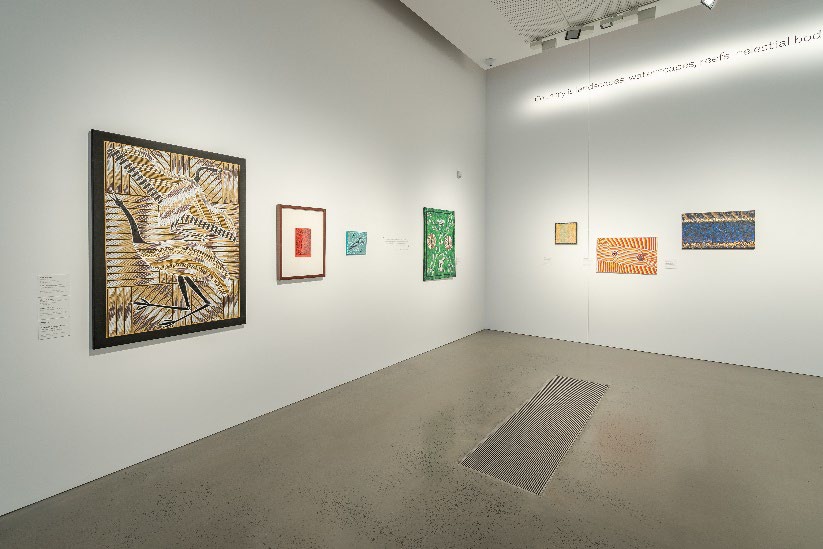
Image: Installation view, ‘The Colour of Country’, Rockhampton Museum of Art, 2022. Photo: Nathan White Images.
The Works
This next section provides a brief summary of the artworks in ‘The Colour of Country.’ Works and artists are discussed in the context of Indigenous relationality.
The first work in the exhibition space is Witheroo Boolaroo 1993 by Alan Hatfield. The work illustrates Darumbal relationships with bird stories which often explain specific types of kinships.. The synergy between art and activism is beautifully exemplified by the organised details of latticed lines. Alan Hatfield as an artist and Native Title applicant is a reminder of Uncle Eddie Koiki Mabo’s artistic expressions through self-portraits and island scapes in pencil and watercolours. Digital reproductions of Uncle Eddie’s works can be found on the National Library of Australia website.
A selection of stories from coastal and desert artists speak to the significance of delicate ecosystems and how Indigenous people live in relationship with sand environments. Central and Western stories of Country from artists include Jilji in Yankurnja Country by Tommy May, Alhalkere (Country) by Dolly Petyarre, Imanara by Cherel Butcher, and Sand Hills Country by George Tuckerbox. Songlines and ceremonies in desert sands and coastal sands show that even in contrasting environments these physical areas are integral to the practice of Indigenous lore. Sand Country exists in relationship with other elements of Country (ie animals, humans, spirits, celestial bodies, wind, Ancestors etc) and not simply defined by its proximity (or lack of) to water or what flora can or can’t grow in it. Pamela Croft’s articulation of these relationships are present in her three directional works. Saltwater Songlines presents the inter-nation relationships between coastal Nations through sand and seas while Tidal Marks is a reminder of the fluid sand seam on coastal Nations between land and sea and Mudflats, Salt and Claypans tell us the nature of these elements on coastal Countries.
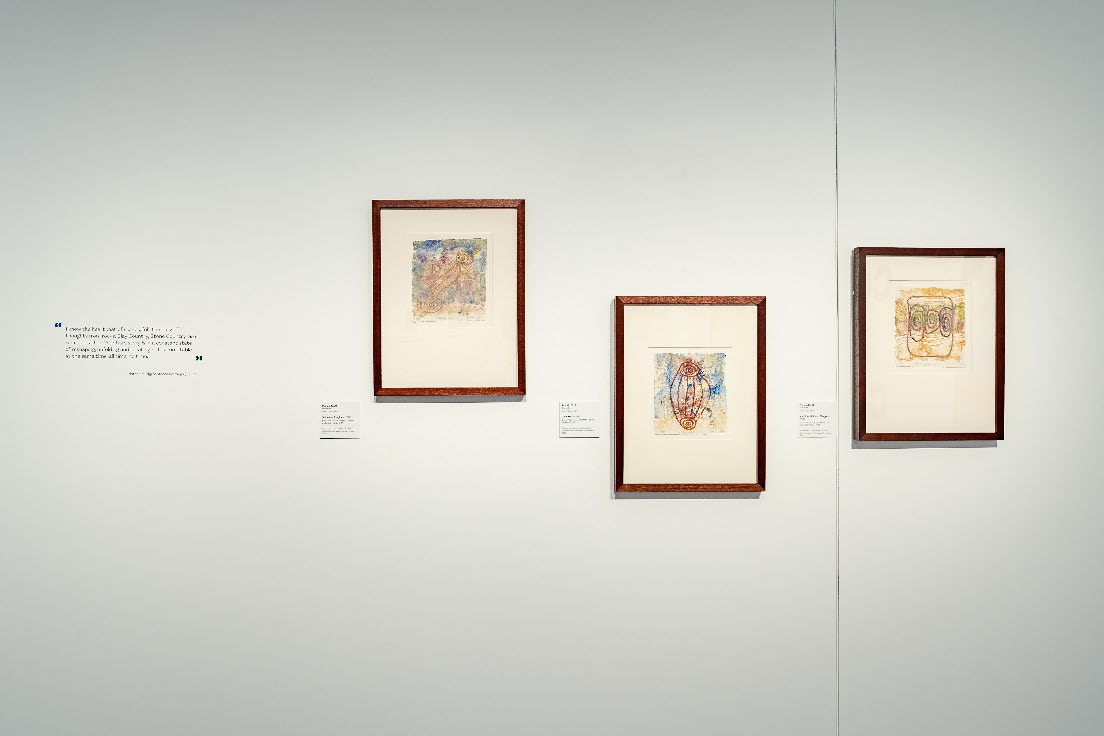
Image: Installation view, ‘The Colour of Country’, Rockhampton Museum of Art, 2022. Photo: Nathan White Images. Images featured left to right: Pamela Croft (b.1955) (Darumbal), Saltwater Songlines 2002 print, clay, ochre, pigment, oil paint and paper, ed. 27 of 60. Commissioned by the Rockhampton Art Gallery 2003. Pamela Croft (b.1955) (Darumbal), Tidal Marks 2002 print, clay, ochre, pigment, oil paint and paper AP1. Commissioned by the Rockhampton Art Gallery 2003. Pamela Croft (b.1955) (Darumbal), Mudflats, Salt and Claypans 2002 print, clay, ochre, pigment,oil paint and paper, ed. 39 of 60. Commissioned by the Rockhampton Art Gallery 2003.
The rain depicted in the works by Rosella Namok in Raining Down at Aangkum and Rainforest both feature striking vertical lines and muted colour tones. In each work rain pours over sections of horizontal brushstrokes, peeking through rain to forests and land and water scapes of eastern Cape York. Namok uses rain as a veil in front of depictions of endless connections to land, seas, celestial bodies, and time. The freefalling movement of water layered and dynamic levels of seeing Country blurs natural and spiritual, the rain signalling multiple kinship interactions are in progress.
Crossover by Howard Butler and Danger – Creek Crossing by Jenuarrie foreground the depth of Aboriginal worlds through the constant presence of spirits relating with humans and non-human beings (i.e. animals). In both works movement is central – Aboriginal animals and Aboriginal people moving in an Aboriginal timeframe through Aboriginal places. In both artworks spirits are in ceremony at either side of the depicted movement. Aboriginal knowledges about the environment are simultaneously scientific and spiritual so Country is known without the conflict of contradiction because science is spiritual.

Image: Installation view, ‘The Colour of Country’, Rockhampton Museum of Art, 2022. Photo: Nathan White Images. Images featured left to right: Rosella Namok (b.1979)(Kanthanampu and Aangkum) , Rainforest 2000, acrylic on canvas. Gift of Andrew Baker through the Australian Government Philanthropy Program 2021. Rosella Namok (b.1979)(Kanthanampu and Aangkum) , Raining Down at Aangkum 2001, acrylic on canvas. Gift of Andrew Baker through the Australian Government Philanthropy Program 2021. Back wall features Mirididingkingathi Juwarnda Sally Gabori (1924-2015), (Kaiadilt), Dibirdibi country 2011, synthetic polymer paint on linen. Gift of Patrick Corrigan AM through the Australian Government’s Cultural Gifts Program 2013.
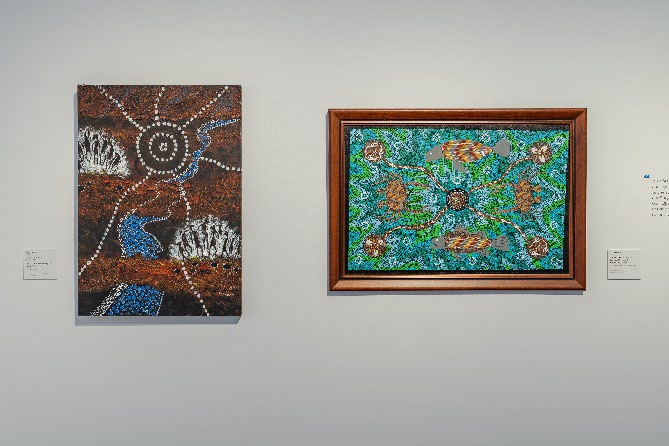
Image: Installation view, ‘The Colour of Country’, Rockhampton Museum of Art, 2022. Photo: Nathan White Images. Images featured left to right Jenuarrie , (b.1944) (Koinjmal), Danger – Creek Crossing in Flood 2007, synthetic polymer paint on canvas. Purchased 2007. G L Row Row, Untitled (Sea Story, with Dugong, Crabs and Barramundi) 2004, synthetic paint n canvas. Gift of Cam Schroder 2008.
Non-human elements of Country are reinforced by G.L Row Row and Rikki-Jo Doyle with both local artists emphasising particular animals in their works. Like Butler and Jenuarrie, Row Row depicts the intersecting of human and non-humans each emanating from their respective places and meeting in ceremony. A dugong, a fish and two crabs positioned around the central ceremony denote kinships that connect specific animals to specific lores. Doyle’s work shows two snakes and two scorpions amongst patterned white, yellow and purple multisized dots. The delicate images of venomous animals emphasise their beauty. There is no human form in either work or warning of danger. Instead, both artists paint relationship without domination and admiration through connection with Indigenous animals.
The works by Miridingkingathi Juwarnda Sally Gabori and Patrick Butcher show the vibrant colours in Country pushing audiences to see beyond the ‘standard’ Aboriginal art modes that often feature earthy tones in dots and lines. Gabori’s work in the exhibition is titled Dibirdibi Country not unlike many of the works she produced before her passing in 2015. Dibirdibi refers to the Rock Cod Ancestor and the lore and kinship Gabori’s husband held for that specific location and story. It is often mentioned that Gabori was the first Kaiadilt artist. While her style might be abstract expressionism, she pours sovereign Kaiadilt woman on to each canvas with expressive freedom to her kin, language, stories and place. The colours dance across the canvas and offer no obvious hint to the sacred lore of the Rock Cod Ancestor Dibirdibi except, perhaps, her complete joy in ‘knowing’.
The Beauty Nature by Patrick Butcher hangs large in the show as a vertical work of blues, reds, pinks, oranges, greens and teals. Like Gabori, Butcher comes from far north Queensland, and uses a non-standard ‘Aboriginal art’ style. In doing so, Butcher embraces and resists the continued colonial definitions of ‘traditional’ Aboriginal art. Butcher is Umpila which goes some way to explain the work and title. Umpila Country is a pristine environment boasting tropical savannahs and rainforests, ocean and ranges. In fact, Umpila Country is reported to be one of the most ecologically intact areas on earth being inaccessible to most Westerners and benefiting from the protection of Aboriginal lores that govern Umpila custodianship of the area with surrounding Nations. Like Gabori’s Kaiadilt people from Bentinck Island, Umpila people were forcibly removed by the government from their lands in the 1940s and were left to fight a Native Title case to prove ownership of the very land which they were extracted from. Patrick Butcher draws on his people’s resistance, his artistic ability, his exquisite Country, his sovereignty and his custodianship to showcase Umpila in his remarkable work The Beauty Nature.
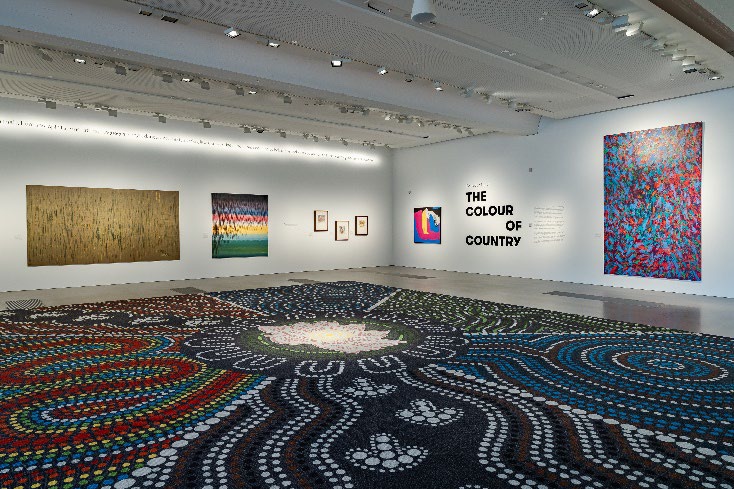
Image: Installation view, ‘The Colour of Country’, Rockhampton Museum of Art, 2022. . Photo: Nathan White Images.
Nullu Muringa by Darumbal artist Raymond Garrett carpets the concrete floor of the gallery. The large colourful floor work takes up the majority of the floor and captures the attention of visitors when entering the space. It was included in the exhibition for four reasons. Firstly, the original artwork was created to celebrate the consent determination for Darumbal Native Title in 2016. It draws down on the Mabo legacy in the adjacent exhibition. Secondly, it depicts Darumbal clans coming together to organise their 25-year pursuit of Native Title. Thirdly, it grounds the gallery space in Darumbal Country. And finally, the work is permanently installed in the Rockhampton Regional Council Town Hall in the Webber Room but is not easily accessed by the general public.
Seven works on loan from two guest community artists complement the Collection Focus. Their inclusion was part of the reciprocal and consensual partnership required for the exhibition with DPAC who directed RMOA to work with the appropriate Torres Strait Islander community leaders. Following these cultural protocols ensured Torres Strait Islander stories were part of the exhibition, given that works by Torres Strait Islander artists have not yet been acquired for the RMOA Collection. The narrative that weaved together works from the collection with temporary loans from Darumbal and Torres Strait Islander artists articulated the local story of Native Title, nation-based organising, and the contribution of Torres Strait Islanders to the local community over decades. This compels the acknowledgement of ongoing management of Country based on the practice of timeless lores.
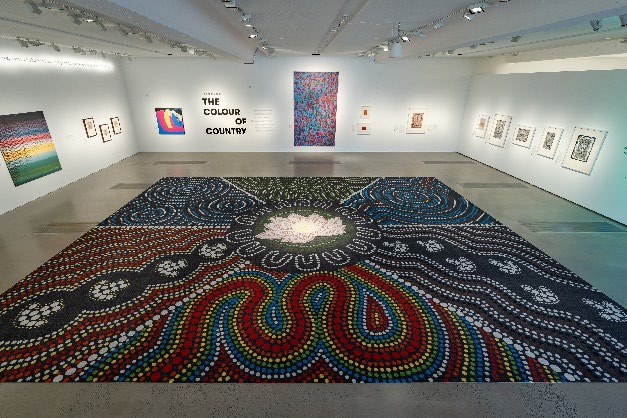
Image: Installation view, ‘The Colour of Country’, Rockhampton Museum of Art, 2022. Photo: Nathan White Images. Carpet:, Raymond Garrett (b.1988) (Darumbal) Nullu Muringa 2020, acrylic carpet. Commissioned through Darumbal Enterprises by Rockhampton Regional Council 2020.
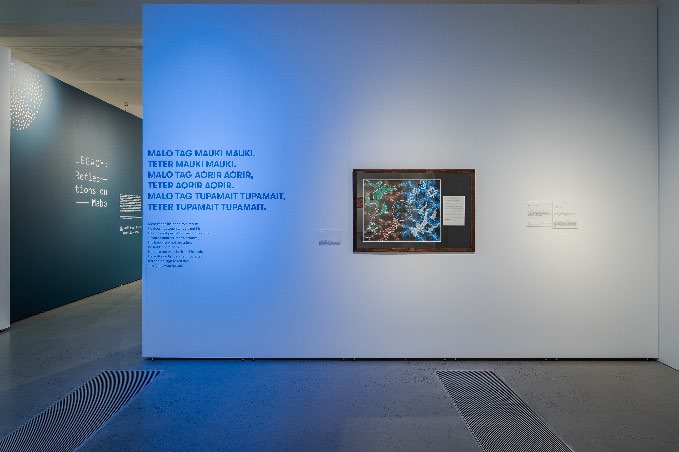
Image: Installation view, ‘The Colour of Country’, Rockhampton Museum of Art, 2022. Photo: Nathan White Images. Image features Lionel Mann (b. 2002) (Darumbal and Daurareb), TUMRA, 2022, synthetic polymer paint on canvas. Courtesy of Darumbal People Aboriginal Corporation RNTBC.
TUMRA by Darumbal and Duareb artist, Lionel Mann, depicts the story of Darumbal strategising and organising based on lore and kinship which led Darumbal people to negotiate the largest Traditional Use of Marine Resources Agreement (TUMRA) on the reef to date. Mann, a Darumbal Ranger, paints the values and principles of Darumbal people as the basis of campaigning for land and sea rights. The crocodile and hammerhead shark featured in the work embody the values and principles of Darumbal people in relation to nation building. TUMRA is accompanied by audio playing in the gallery space. The recording is of reef chatter obtained via hypdrophones provided by Darumbal Enterprises (home of the TUMRA artwork and coordination of the TUMRA) through their partnership with the Commonwealth Scientific and Industrial Research Organisation (CSIRO) and Great Barrier Reef Marine Park Authority (GBRMPA).
A set of six lino prints loaned from Aunty Annie Abednego Gela are a highlight of the exhibition. Aunty Annie is a deeply respected Torres Strait Islander Elder and Rockhampton community leader. Her exceptional story-telling and artistic ability combine to create intricate works depicting the behaviours of celestial bodies, animals, protocols and people. The condition for exhibition of Aunty Annie’s works were for the inclusion of artist statements with each work and no photography permitted of the works or statements. The statements included the cultural significance and story of each work. This condition will be respected here in this essay and no further information or details shared except the list of titles of these incredible works:
- Capricorn Coast
- Beizam Le Segur (Shark play / shark man dance)
- Madthub en Woemer (Kindred Spirits of Nature)
- Gawei Segur (Pelican Dance Culture Unmasked)
- Kisai en Aukam (The Moon and Aukam)
- Kupai Kazil Omasker
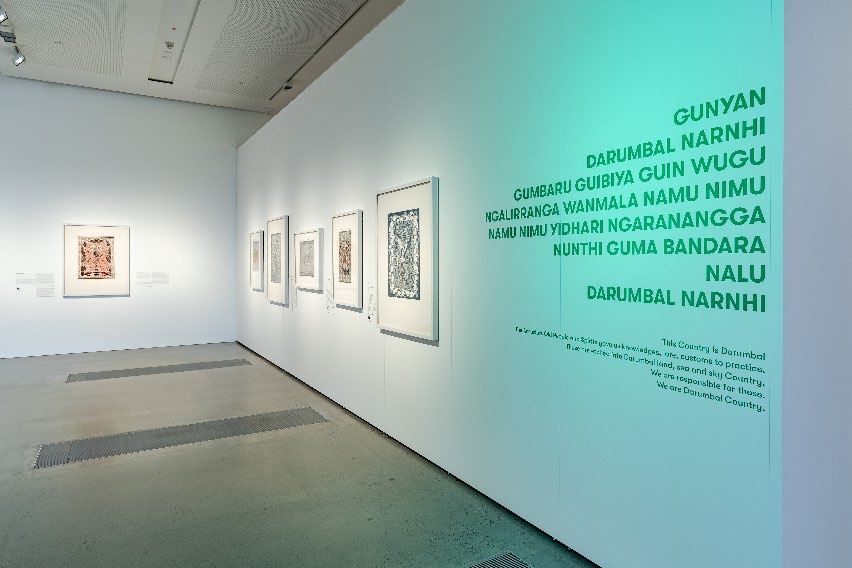
Image: Installation view, ‘The Colour of Country’, Rockhampton Museum of Art, 2022. Photo: Nathan White Images. Abednego Gela, Mer. Specific image used with written consent of the artist for the purpose of this essay ONLY.
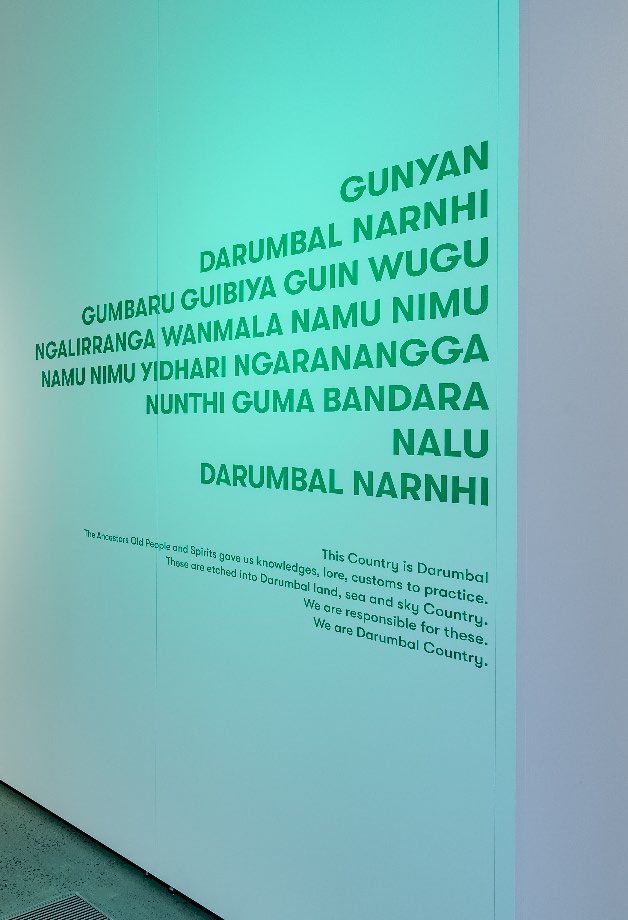
Image: Installation view, ‘The Colour of Country’, Rockhampton Museum of Art, 2022. Photo: Nathan White Images.
The exhibition includes a visual conversation between Darumbal and Meriam Mir languages reflecting the co-curators’ Mobs and used with permission from respective Elders. Darumbal phrasing reiterates the principles and values expressed in Darumbal artworks TUMRA and Nullu Muringa and the audio of reef chatter. Meriam Mir states the powerful Malo Law. Both texts are set in large upper-case lettering and lighting in green (Darumbal) and blue (Meriam Mir) also denoting the colours of skies, waters, grasses, rainforests, and bushlands. The text installation gives prominence to Aboriginal and Torres Strait Islander lore that governs all aspects of Country. As visitors physically pass between the wall texts to either exit or enter the gallery space to the adjacent exhibition, ‘Legacy: Reflection on Mabo,’ they move from Indigenous lores of Country to representations of the collision of those lores with Western land laws. The Mabo Case is arguably one of the most significant legal challenges in the history of colonised Australia.
Other texts on the walls include quotes from Ghungulu, Bidjara, Garingbal, Wiradjuri and Darumbal people. Each person was briefed on the exhibition and asked to respond to the theme of sea, sand, spirits, sky, rain. The additional commentary from individuals adds further depth to the collective views of Country from Indigenous peoples.
The last section of the exhibition discussed in this essay is, yet another wall text written by this author. Positioned high on the longest of the gallery walls, the inclusion of the single sentence was an attempt to define the indefinable; to ensure visitors had a chance to understand the concept of Country as lived by Aboriginal and Torres Strait Islander people. It is a contextual and visual effort to be comprehensive and uncomplicated about the meaning of the exhibition.
“Country is landscapes, waterscapes, reefs, celestial bodies, wind, animals, humans, spirits, Ancestors, languages, songs, dances, rock art, stories, laws, knowledges and time; each entity holds lores and kinships unique to their precise geographical location”
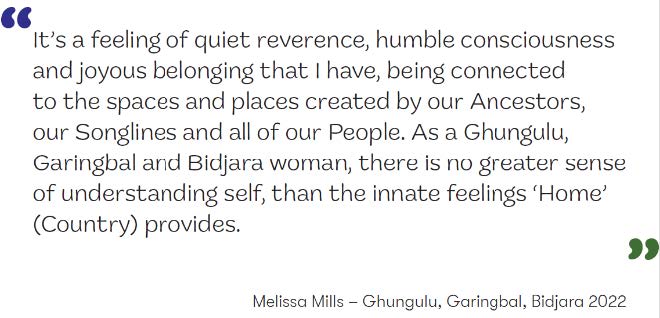
One Final Point
‘The Colour of Country’ was the first all-Indigenous Collection Focus exhibition at the new home of Rockhampton Museum of Art’s collection. It highlighted small local artists alongside the internationally acclaimed. It brought together sounds and languages from particular Countries and loans of works from specific Indigneous community members demonstrating the dynamics of First Nations’ lores in a contemporary regional gallery setting. Perhaps the most significant impact of ‘The Colour of Country’ will be the mark it leaves to build a justification for future Collection Focus exhibitions of First Nations artists and the priority for First Nations art acquisitions at RMOA. In any case, the exhibition has attempted to educate the local community and visitors to the region that the worldviews of Aboriginal and Torres Strait Islander people are grounded in vibrant kinships governed by lores with humans, non-humans, environments and knowledges. ‘The Colour of Country’ is the antithesis of ‘terra nullius.’ To borrow from common protest chants used by Indigenous people, ‘The Colour of Country’ exhibition is ‘always was and always will be’ and it is a reminder of ‘sovereignty never ceded’ because we are ‘still here’.
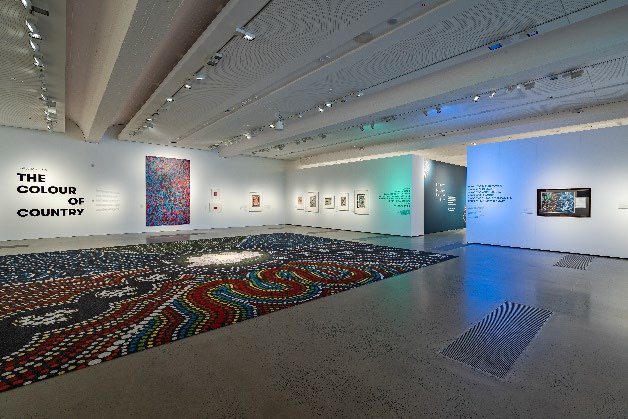
Image: Installation view, ‘The Colour of Country’, Rockhampton Museum of Art, 2022. Photo: Nathan White Images.
Reference List
Australian Government (2022) Monitoring vessel activity with hydrophones. Great Barrier Reef Marine Park Authority. Accessed 5 December, 2022. https://www2.gbrmpa.gov.au/news/monitoring-vessel-activity-hydrophones
Gorringe, S., Ross, J., Fforde, C. ‘Will the Real Aborigine Please Stand Up’: Strategies for breaking the stereotypes and changing the conversation’. AIATSIS Research Discussion Paper. No 28. https://aiatsis.gov.au/sites/default/files/research_pub/gorringe-ross-fforde-dp28-real-aborigines-stereotypes_0_2.pdf
Hooton, A. (2014) Umpila country – the land of the living. The Sydney Morning Herald. Accessed 7 December, 2022. https://www.smh.com.au/lifestyle/umpila-country--the-land-of-the-living-20141107-11in9j.html
Janke, T. (2018) First Peoples: A Roadmap for Enhancing Indigenous Engagement in Museums and Galleries, Australian Museums and Galleries Association
McCoy, M. L., Elliott-Groves, E., Sabzalian, L., Bang, M. (2020) Restoring Indigenous Systems of Relationality. Humans Nature. Accessed 14 December, 2022. https://humansandnature.org/restoring-indigenous-systems-of-relationality/
McClean I. (2015) Sally Gabori: Dibirdibi Country. Queensland Art Gallery Board of Trustees, 2023. Accessed 7 December, 2022. https://blog.qagoma.qld.gov.au/sally-gabori-dibirdibi-country-australia/
McLean, I. (2016) Here’s Looking at: Dibirdibi Country – Topway by Mirdidingkingathi Juwarnda Sally Gabori. The Conversation. Accessed 14 December, 2022. https://theconversation.com/heres-looking-at-dibirdibi-country-topway-by-mirdidingkingathi-juwarnda-sally-gabori-62114
Watego, C. (2017) Is chronicling Indigenous despair the only way we can get on television?’ The Guardian. Accessed 23 January 2023. https://www.theguardian.com/commentisfree/2017/nov/28/is-chronicling-indigenous-despair-the-only-way-we-can-get-on-television